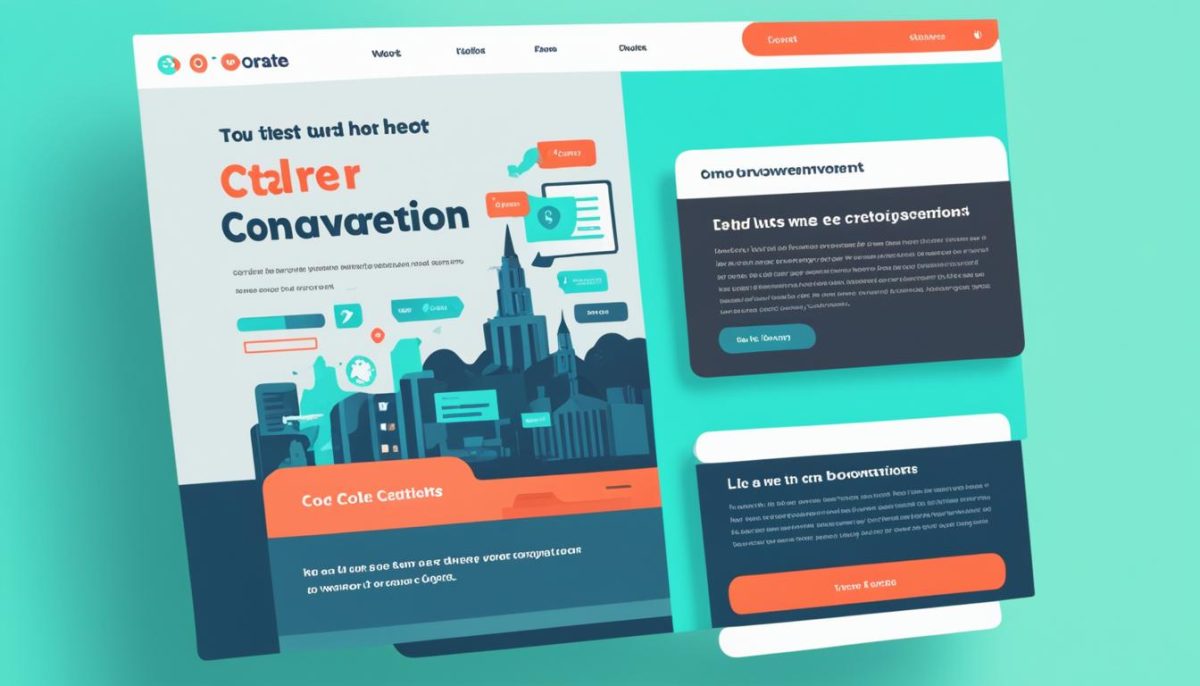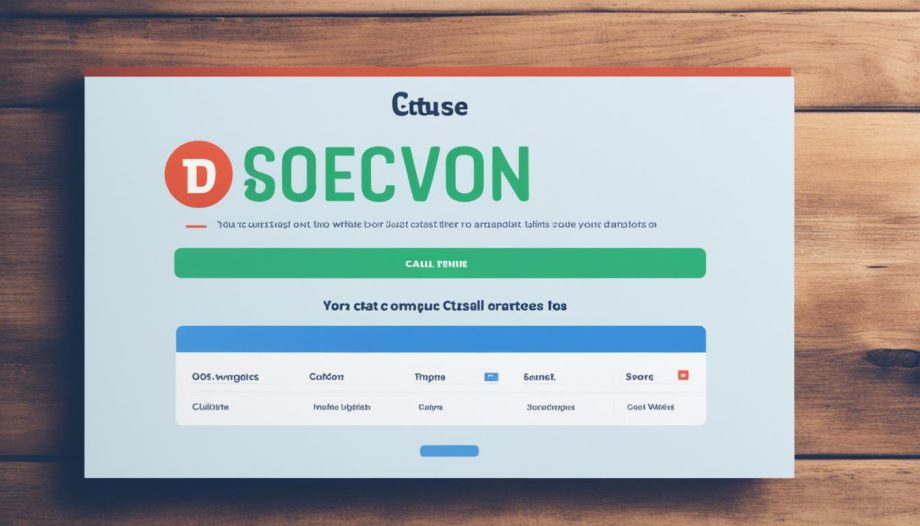Welcome to the first section of our article, where we will explore the significance of having a Call-to-Action (CTA) on your website. As an experienced copywriting journalist, I understand the importance of engaging your audience and driving them to take action. A well-designed CTA plays a vital role in achieving these objectives.
By strategically placing CTAs throughout your website, you can guide visitors to perform specific actions that align with your business goals. Whether it’s encouraging them to make a purchase, sign up for a newsletter, or request more information, CTAs provide clear directions and drive user engagement.
In the following sections, we will dive deeper into the benefits of a well-executed CTA. We will discuss how it enhances the overall user experience, drives conversions, and creates a seamless user journey. By the end of this article, you will have a comprehensive understanding of how a well-placed and optimized CTA can optimize your website’s performance.
So buckle up, and let’s explore why a CTA is an essential element for success on your website!
Boost User Engagement with a Clear CTA
A clear and compelling Call-to-Action (CTA) serves as a guide for your visitors, directing them to the desired action on your website. Whether it’s signing up for a newsletter, making a purchase, or requesting more information, a well-placed CTA can significantly increase user engagement. By strategically placing CTAs throughout your website, you can capture your visitors’ attention and motivate them to take the desired action.
Creating an effective CTA involves careful consideration of design, placement, and messaging. The visual elements, such as color and size, should be attention-grabbing without overwhelming the overall design. Utilizing contrasting colors can help draw users’ eyes to the CTA, making it more noticeable. Additionally, using action verbs in the CTA text can instill a sense of urgency and prompt immediate action.
Placing the CTA in a prominent location on the webpage is crucial. Ideally, it should be above the fold, ensuring that users see it without having to scroll down. Placing the CTA near relevant content can also increase its effectiveness. For example, if you have a product page, including a CTA for purchasing the product right after the product description can encourage users to take action while their interest is high.
“A clear and compelling CTA serves as a guide for your visitors, directing them to the desired action on your website.”
Remember to keep your CTAs concise and straightforward. Avoid using jargon or complex language that might confuse or deter users. Instead, focus on creating clear and concise messaging that clearly communicates the value proposition and desired action to users.
Different Types of CTAs
CTAs come in various forms, and the most suitable type depends on the specific goal of your website. Some commonly used CTAs include:
- Button CTAs: These are typically placed at the end of blog posts, product descriptions, or landing pages, and they prompt users to take action like signing up, making a purchase, or downloading a resource.
- Text Links: These can be used within the content to guide users to related pages, encouraging them to explore further and increase their engagement.
- Pop-up CTAs: Pop-ups are attention-grabbing and can be highly effective when used sparingly. They can be used to collect email addresses, offer discounts, or highlight limited-time promotions.
By using a combination of these different CTAs, you can create a well-rounded user experience that encourages engagement throughout the customer journey.

| Benefits of a Clear CTA | Strategies for Creating an Effective CTA |
|---|---|
| 1. Increased user engagement | 1. Use compelling language and action verbs |
| 2. Higher conversion rates | 2. Ensure visibility and prominence |
| 3. Improved user experience | 3. Keep the CTA concise and straightforward |
| 4. Clear direction for visitors | 4. Test and optimize your CTAs |
Ultimately, a well-designed and strategically placed CTA can significantly boost user engagement and drive conversion rates on your website. By following best practices and continually testing and optimizing your CTAs, you can ensure that your website effectively prompts users to take the desired action, leading to a more successful online presence.
Drive Conversions and Achieve Business Goals
A website without a strong Call-to-Action (CTA) is like a ship without a rudder. Without clear direction, visitors may leave your site without taking any action. In today’s digital age, where competition is fierce, it is essential to have an optimized CTA that can drive conversions and help you achieve your business goals.
To harness the true power of a CTA, it is crucial to align it with your overall marketing strategy. Your CTA should reflect your brand’s values, speak to your target audience, and entice them to take the desired action. By integrating a well-designed and strategically placed CTA throughout your website, you can guide your visitors towards the next step in their customer journey.
When optimizing your CTA, consider the following best practices:
- Craft compelling copy: Use persuasive language and engaging visuals to captivate your visitors. Clearly communicate the value proposition and benefits of taking the desired action.
- Highlight urgency: Create a sense of urgency by incorporating time-limited offers or limited availability to encourage immediate action.
- Optimize for mobile: With the rise of mobile browsing, ensure that your CTA is fully responsive and easy to click on smaller screens.
- A/B test: Experiment with different variations of your CTA to identify the most effective design, placement, and messaging.
Remember, a well-optimized CTA can significantly impact your conversion rates and business success. It provides a clear path for your visitors, facilitating their journey from prospect to customer. Take the time to analyze the performance of your CTAs and make data-driven adjustments to continually improve their effectiveness.
By following these strategies and continuously refining your approach, you can maximize the potential of your CTAs and propel your business towards achieving its goals.

Testimonial
“Since implementing a clear and compelling CTA on our website, we have seen a significant increase in conversions. Our visitors now have a clear path to follow, and we are achieving our business goals more effectively than ever before.” – Sarah Johnson, Marketing Director
Create a Seamless User Journey with an Effective CTA
A well-designed Call-to-Action (CTA) not only encourages users to take immediate action but also plays a crucial role in creating a seamless user journey throughout your website. By strategically placing CTAs at key touchpoints, you can guide users through your site and towards the next step in the conversion process.
When it comes to integrating CTAs into your website’s design and content, it’s essential to follow best practices. First and foremost, make sure your CTAs are visually appealing and stand out from the rest of the page. Use contrasting colors, compelling copy, and relevant imagery to capture users’ attention and entice them to click.
Additionally, consider the placement and timing of your CTAs. Position them strategically on the page where users are most likely to notice and engage with them. Experiment with different locations and monitor the data to determine what works best for your target audience. Furthermore, use targeted messaging and language that aligns with the specific action you want users to take.
By implementing these effective strategies for creating CTAs, you can optimize the user journey on your website. A well-executed CTA not only enhances the user experience but also increases the chances of conversion. So, take the time to evaluate your website’s CTAs and make the necessary improvements to drive engagement and achieve your business goals.




